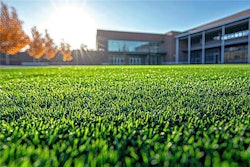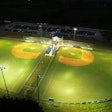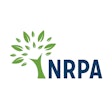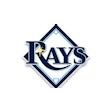![[Photo courtesy of Fort Worth Paschal High School]](https://img.athleticbusiness.com/files/base/abmedia/all/image/2016/04/ab.Turf-416_feat.png?auto=format%2Ccompress&q=70&w=400)
This article appeared in the April issue of Athletic Business. Athletic Business is a free magazine for professionals in the athletic, fitness and recreation industry. Click here to subscribe.
"Nothing is more important than the safety of our children." So opens a video released jointly by the Safe Fields Alliance and the Recycled Rubber Council this past February. The video, titled "The Truth About Crumb Rubber and Artificial Turf," mentions the words "safe" or "safety" 10 times in seven minutes. It's the most visible effort yet by turf industry advocates to counter mainstream media reports — what the video terms "scary news stories" — that seem to lend credence to suspicions that crumb rubber infill in synthetic turf sports fields may cause cancer, even as these same reports admit, as NBC Nightly News did Oct. 1 of last year, "No research has linked crumb rubber or shredded rubber to cancer."
Log in to view the full article
This article appeared in the April issue of Athletic Business. Athletic Business is a free magazine for professionals in the athletic, fitness and recreation industry. Click here to subscribe.
"Nothing is more important than the safety of our children." So opens a video released jointly by the Safe Fields Alliance and the Recycled Rubber Council this past February. The video, titled "The Truth About Crumb Rubber and Artificial Turf," mentions the words "safe" or "safety" 10 times in seven minutes. It's the most visible effort yet by turf industry advocates to counter mainstream media reports — what the video terms "scary news stories" — that seem to lend credence to suspicions that crumb rubber infill in synthetic turf sports fields may cause cancer, even as these same reports admit, as NBC Nightly News did Oct. 1 of last year, "No research has linked crumb rubber or shredded rubber to cancer."
At the center of NBC's two-part "Fields of Danger?" report that aired last fall — as well as the network's initial investigation a year earlier — is Amy Griffin. The associate head women's soccer coach at the University of Washington first drew the attention of local affiliate KOMO with a list she began compiling of young players, predominantly goalkeepers, who had been exposed to crumb rubber, the product of recycled car tires, and become ill — her personal exercise in curiosity as much as insisting cause and effect.
"Right now, there's no way to prove that enough of any of this is getting into us that it's actually a direct link. But, that was my gut feeling," says Griffin, who has coached goalkeepers for Washington's women's team for 20 years and long wondered if carcinogenic components in car tires could be rendered toxic in particle form and under certain conditions. "Even on their busiest days, keepers are not rolling around on the turf. But in training, we hit the ground hundreds of times, and especially on a hot day, the crumb rubber sticks to you. So every way it could enter a body and become an issue, we're getting it a lot. We eat it by accident, we get it in our abrasions, we get it in our eyes, and we breathe."
![[Photo courtesy of the University of Tennessee Center for Athletic Field Safety]](https://img.athleticbusiness.com/files/base/abmedia/all/image/2016/04/ab.turf2_300x199.png?auto=format%2Ccompress&fit=max&q=70&w=400) [Photo courtesy of the University of Tennessee Center for Athletic Field Safety]
[Photo courtesy of the University of Tennessee Center for Athletic Field Safety]
ANECDOTAL CONCERN
As of this writing, Griffin's list contained the names of 203 athletes with a confirmed cancer diagnosis. The 159 soccer players listed included 103 goalkeepers. All but a handful of the 203 have played on synthetic turf containing crumb rubber. Thirty-six have died, including 11 in 2015 alone.
"This is just a goalkeeper coach looking at the list, but it seems like the ones with the blood-related cancers are the ones who have played a significant amount on crumb rubber, and if there's someone with melanoma, it's one who has never played on crumb rubber," Griffin says, adding that more than one scientist on the UW campus has told her that she's "on to something" (her words). For confirmation, Griffin turned her list over to Washington's Department of Health, which has been cross-referencing the coach's data against state cancer registries to see if rates of diagnosis are consistent or cause for alarm. The DOH told AB its findings will be released in late spring.
"Obviously, this is a very serious issue. Cancer is a health effect that is very concerning," says Michael Peterson, senior toxicologist at Gradient Consulting and scientific adviser to the Recycled Rubber Council, who cautions, "Just based on how epidemiology studies are conducted, it's very difficult to find a comparison population to soccer players. The good news is it's being looked at, but it's going to be hard for Washington state to make any definitive conclusions because this list is just completely anecdotal at this point."
MOUNTING SKEPTICISM
Between 2009 and 2011, limited studies by government agencies in New York, Connecticut and New Jersey did not find an elevated health risk associated with exposure to fields containing crumb rubber. Meanwhile, individuals including members of the medical community have weighed in as well. "It's incredibly difficult to ascribe a cause to a specific type of cancer, since there can be many factors leading to cancer formation," writes Dev Mishra, a clinical assistant professor of orthopedic surgery at Stanford University, on SidelineSportsDoc.com. "Witness the fact that it took several decades to prove that cigarette smoking can cause lung cancer."
Says John Sorochan, a University of Tennessee turf grass professor and founder of the Center for Athletic Field Safety, "Of course, we need to look at things. Dose equals poison. Paracelsus told us that in the 1400s. Water's a poison if you consume too much water."
Sorochan's corner of the Knoxville campus contains 72 sports surface swatches, including 40 synthetic turf systems, which reside over pond liners from which water samples are gathered during leachate studies. Sorochan asserts that it's "highly unlikely" athletes are subject to high enough doses of ingredients extracted from recycled rubber to cause health issues.
"I guess this is me on my soapbox, but I have an eight-year-old and an 11-year-old who play travel soccer," he says. "They train three times a week on an artificial field. My youngest has been playing since he was four years old on an artificial field, so he's a lot closer to the surface than goalies are. And kids fall down all the time. It's the whole reason I got into doing what I do, and why we have the Center for Athletic Field Safety."
Sorochan is also quick to point out that linemen and running backs in football, a sport that has embraced crumb rubber synthetic surfaces for longer and in far greater numbers than has the soccer community, come in direct contact with infill exponentially more often than do soccer goalkeepers. But his skepticism transcends sports. "If you look at the real-world perspective, we have a quarter of a billion cars on the road every day, which means there are a billion car tires. You have to replace your car tires because the rubber wears, and it wears down into a fine particulate. If you're looking at what you put in a synthetic field, you're looking at a really course particle size, whereas car tires break down into a fine dust. Then every time it rains, that tire debris washes into our sewer systems and goes directly into our rivers and streams. If there's a contamination concern, it would be way greater in urban areas from car tires being driven up and down the streets than it would from crumb rubber on athletic fields."
INDUSTRY FRUSTRATED, THRIVING
The cloud of confusion has not lingered without producing some fallout. While a majority of municipalities and school districts have opted to maintain the status quo in terms of their synthetic turf fields in the absence of evidence linking crumb rubber to health risks, others have cancelled planned installations. Still others have decided to stick with crumb rubber for now, but transition to organic infill alternatives such as cork or coconut fiber as new fields are constructed.
It's a luxury of choice that has faced legislative threat. In 2014, the California Tire Dealers Association helped defeat a bill that would have placed a moratorium on schools and municipalities installing crumb rubber athletic fields in that state, which is already home to more than 900 synthetic turf fields. The bill also would have kept the California Department of Resources Recovery and Recycling from issuing grants or rebates to synthetic turf producers and end users.
"What is so frustrating for the industry is that the critics perpetuating these persistent unfounded concerns continue to utilize half-truths and outright false statements that continue to frighten and alarm parents and public officials," says Al Garver, president of the Synthetic Turf Council, a nonprofit association that has done its part to clear the air with informational toolkits. "Between October 2014 and October 2015, we sent out hundreds of those electronically, and our members would also provide them when the issue would come up from their customers or within their region. Over the course of that year, many of those entities investigated the unfounded claims, discovered the available studies, and came to the same conclusions nearly every one of 60-plus studies did: There is nothing that indicates elevated risk. To our knowledge, all have kept their fields or are continuing to purchase. We have heard of a few that opted to change to an alternative infill, but demand for synthetic turf fields continued to increase in 2015. We estimate 1,500 fields were built, with more than 13,000 in use today in America."
FILLING DATA GAPS
Last fall, a three-year study considered by some to be the most comprehensive to date began with three workshops and a webinar to assess and ultimately address as many crumb rubber concerns as possible. Funded by CalRecycle, the $3 million study is the third on the topic conducted by California's Office of Environmental Health Hazard Assessment, which, with help from the U.S. Environmental Protection Agency, will look at the potential impact on crumb rubber of such factors as heat and turf system lifecycle — two items that have bothered Griffin by their absence in existing research.
Even those who have conducted studies have recognized their limitations. Last August, the U.S. Consumer Product Safety Commission announced that 2008 research was "not good enough" to claim whether or not crumb rubber is safe, reversing its longstanding opinion that it is. The EPA likewise has backtracked from 2009 claims that crumb rubber posed "low levels of concern." On Feb. 12 of this year, the Obama administration announced that the CPSC, the EPA and the Agency for Toxic Substances and Disease Registry at the Centers for Disease Control and Prevention — 50 federal employees in all — will conduct a new $2 million federal study.
RESOURCES
www.recycledrubbercouncil.org
www.safefieldsalliance.com
www.syntheticturfcouncil.org
That announcement does not change plans for the California study, according to Sam Delson, the OEHHA's deputy director for external and legislative affairs. "We're looking to fill in the most significant data gaps from the previous research, but it could take more than three years and the $3 million that we have for this study to answer every possible question," he says. "We're going to do our best to address the concerns that many parents, coaches and athletes have over the safety of this surface. There's nothing more important than the safety of our children and young athletes who, as bodies are developing, are especially susceptible to health risks in many cases, and we expect to significantly advance the body of knowledge on this subject."
While the study won't be completed until 2018, the OEHHA intends to release in 2017 preliminary findings that will inform the design of additional research protocols — perhaps involving biomonitoring of athletes. Time will tell whether such efforts will quell remaining concerns, particularly those of one curious soccer coach.
"As far as Amy Griffin, we applaud her efforts to raise attention to her concerns about the potential health effects of synthetic turf, and certainly the number of names she's collected raises concerns," Delson says. "But that information in and of itself is not statistically valid, so we need to build on that and go further to answer these questions. As I understand, she would be one of the first to acknowledge that."
"There will always be skeptics in the scientific field. It's impossible to prove that there's no risk. It's impossible to prove a negative," adds the RRC's Peterson, who has examined product safety for 20 years. "However, the California study is going to cover a huge variety of different end points and exposure scenarios. And I would hope that if that study comes back with a clean bill of health it would put this issue to bed."
The Synthetic Turf Council is likewise looking for closure. In a Feb. 12 statement, the council said it hopes the federal government's renewed involvement will "settle this matter once and for all."
"We have consistently said that we support all additional research," the statement reads. "At the same time, we strongly reaffirm that the existing studies clearly show that artificial turf fields and playgrounds with crumb rubber infill are safe and have no link to any health issues."
This article originally appeared in the April 2016 issue of Athletic Business with the title "The Case for Crumb Rubber"





































